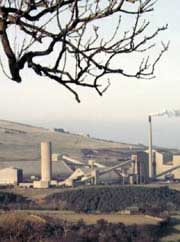Xenon outs WIMPs

The UK’s Dark Matter Collaboration’s detector lab in Buolby Mine, Yorkshire.
Dark-matter detector could pin down the Universe’s missing mass.
Researchers in London are building a cheap dark-matter detector that should be able to spot the exotic particles called WIMPs that are suspected of hiding most of the Universe’s missing mass1.
A prototype of the detector has just shown, for the first time, that it can spot something as close to a WIMP as it’s possible to produce in the lab.
WIMP stands for ’weakly interacting massive particle’. If WIMPs exist at all, they are thought to be hefty compared to the protons and neutrons in an atomic nucleus, but to barely interact with these components of normal matter.
Physicists believe that WIMPs make up as much as 99% of the total mass of the Universe. Astronomers can’t see this matter – hence its ’dark’ moniker – but they can see its gravitational effects on the way the stars and gas in galaxies rotate.
Even if billions of WIMPs are streaming through our bodies, they don’t have any effect. So WIMP-hunting could be a frustrating affair – like trying to fish for shrimps using the net from a football goal.
Several experiments are currently going to great lengths in the search for WIMPS. The problem is that detectors capable of WIMP-spotting will probably pick up other cosmic particles, too, swamping the WIMP signal. Cosmic rays – high-energy particles of normal matter from space – and radioactive emissions would also register.
To shield a WIMP-detector from cosmic rays, it must be placed deep underground. The UK Dark Matter Collaboration (UKDMC) houses detectors at a depth of 1,100 metres in a salt mine in Yorkshire. Another array in Italy is buried in a tunnel beneath a mountain.
It would all be a lot easier if a detector could differentiate between a cosmic ray and a WIMP. Last year Alex Howard and co-workers at Imperial College, London, proposed a new type of WIMP detector that could, in principle, do just that. The simple device contains liquid and gaseous xenon.
Howard’s team said that WIMPs entering the detector would occasionally collide with the nucleus of a xenon atom, causing a brief flash of light called a primary scintillation and removing an electron from the atom. An electric field would pull these electrons through the liquid into the xenon gas, where they would induce a secondary scintillation flash.
These two distinct events are crucial to WIMP identification. Other particles, such as cosmic rays, induce the same processes. But the brightness of the primary and secondary scintillations would be different for WIMPs, cosmic rays and other particles.
The closest thing to a WIMP that the researchers could use readily to test their device is a neutron. So they teamed up with Farhat Beg and colleagues, also at Imperial, who have developed a cheap and convenient table-top source of neutron beams called a plasma focus. Neutrons for scientific research are usually generated in nuclear reactors.
Using this source, the Imperial researchers show that the xenon detector spots and identifies neutrons, implying that it should be able to do the same with WIMPs. Indeed, neutrons give a signal so much like that of WIMPs that the remaining challenge will be to tell them apart.
“We’re now making a full-scale detector,” Howard says. They hope to install it in the UKDMC mine in the next 12 to 18 months.
References
- Beg, F. N. et al. Table-top neutron source for characterization and calibration of dark matter detectors. Applied Physics Letters, 80, 3009 – 3011, (2002).
Media Contact
All latest news from the category: Physics and Astronomy
This area deals with the fundamental laws and building blocks of nature and how they interact, the properties and the behavior of matter, and research into space and time and their structures.
innovations-report provides in-depth reports and articles on subjects such as astrophysics, laser technologies, nuclear, quantum, particle and solid-state physics, nanotechnologies, planetary research and findings (Mars, Venus) and developments related to the Hubble Telescope.
Newest articles

Durable, Efficient, Sustainable: The Rise of Cerium Oxide Thermal Switches
Groundbreaking cerium oxide-based thermal switches achieve remarkable performance, transforming heat flow control with sustainable and efficient technology. Cerium Oxide-Based Thermal Switches Revolutionize Heat Flow Control Thermal switches, which electrically control…

How Industrial Robots are Reducing Emissions in Global Manufacturing
A new study explores the intersection of industrial automation and environmental sustainability, focusing on the role of industrial robots in reducing the carbon intensity of manufacturing exports. The research demonstrates…

Patients Can Heal Through Precise, Personalized Bioceramic Grafts
A recent review is transforming the landscape of craniomaxillofacial bone regeneration with the introduction of personalized bioceramic grafts. This pioneering research explores the fabrication and clinical potential of synthetic grafts…



